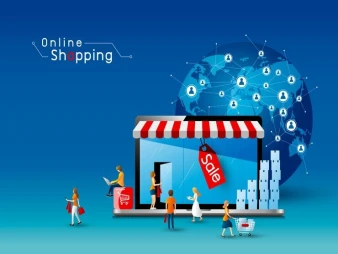Free support 24/7
Free support 24/7

What are the most popular and effective types of marketing?
Marketing is the process of planning and implementing strategies to connect with potential and existing customers, deliver value to them, and achieve business goals. Marketing includes a set of activities and tools that help identify the target market, understand its needs and desires, develop products or services that meet those needs and desires, determine the appropriate price, promote products or services through different channels, distribute them in effective ways, and build long-term relationships with customers.
There are many different types of marketing that can be used to achieve these goals, each with specific characteristics, advantages, and challenges. In this article, we will review the most popular and effective types of marketing in our time, and we will explain the concept of each type, examples of its use, and the difference between it and other types of marketing.
First: Digital Marketing
Digital marketing is a type of marketing that uses the Internet and digital technology to promote products, services, or brands. Digital marketing includes using a set of different tools and strategies to reach the target audience through digital channels such as:
Search Engine Marketing: It is the use of paid or unpaid methods to increase the visibility of a website or page on search engine results such as Google or Bing. Unpaid methods include Search Engine Optimization, which is the application of a set of technologies to make content more relevant and of better quality to the search terms used. Paid methods include search engine advertising, which is paying a certain amount to appear in the first positions of search results.
Social Media Marketing: It is the use of social media platforms such as Facebook, Twitter, Instagram or YouTube to interact with the audience and increase awareness of the brand and products or services. Social media includes the use of paid or unpaid methods to increase followers, shares, likes and comments. Unpaid methods include publishing attractive, useful and appropriate content for the target audience. Paid methods include social media advertising, which is paying a certain amount to appear in the ads box, in the news feed, or in user stories.
Email Marketing: The use of email to send marketing messages to a list of potential or existing subscribers or customers. Email marketing includes creating messages with attractive titles, interesting content, and valuable offers, and sending them on a regular and appropriate basis to increase the chances of opening them and clicking on the attached links.
Content Marketing: It is the use of content in various forms such as articles, videos, images, podcasts, or e-books to attract and arouse audience interest, enrich their knowledge, and solve their problems. Content marketing includes creating valuable and high-quality content, publishing it on various digital channels such as blogs, websites, social media, or YouTube channels, and optimizing it to increase its visibility on search engines.
Mobile Marketing: It is the use of a mobile phone as a tool to promote products, services or brands. Mobile marketing includes the use of various methods such as:
SMS Marketing: Sending short text messages containing offers or discounts
Mobile applications (App Marketing): It is the creation of mobile applications that provide useful services or content to users, and encourage them to download, use and share them with others.
Push Notifications: It is sending messages that appear on the mobile phone screen to users who have downloaded a specific application, and contain reminders, updates, or special offers.
Quick Response Codes (QR Codes): Square codes that contain encoded information that can be read by a mobile phone's camera, and direct the user to a website or web page with more information or offers.
Second: Influencer Marketing
Influencer marketing is a type of marketing that uses personalities who are influential in a specific field or have a large audience on social media to promote products, services, or brands. Influencer marketing involves contracting with influencers to create and publish content that mentions the product, service, or brand in a positive and honest way, and encourages their audience to try or buy it. Influencer marketing is characterized by the fact that it benefits from the trust, honesty, and popularity of the influencer, and sends a powerful marketing message to the target audience.
Third: Buzz Marketing or buzz marketing
Buzz marketing or buzz marketing is a type of marketing that uses a technique to attract the audience's attention, arouse their curiosity, and occupy their conversation with the product, service, or brand. Buzz marketing involves using innovative and unconventional methods to create buzz around a product, service, or brand, such as:
Using secrecy, ambiguity, and allusions to spark curiosity and anticipation.
Using controversy, excitement, and surprise to attract attention and discussion.
Use humor, creativity and entertainment to entertain the audience and increase participation.
Using interactive campaigns and audience participation to increase exposure and social proof.
Fourth: Traditional Marketing
Traditional marketing is a type of marketing that uses traditional, non-digital media to promote products, services, or brands. Traditional marketing includes the use of methods such as:
Word of Mouth Marketing: It is the use of the spoken word to promote a particular product or service. Word of mouth marketing can be either through friends and family or through current and former customers Word of mouth can be very influential, as it relies heavily on interpersonal trust.
Media Marketing: It is the use of traditional media such as television, radio, newspapers, magazines, and print commercials to promote products or services.
Personal Marketing: The use of personal sales to promote products or services. This includes visiting potential customers at their homes or offices or making presentations of products or services at exhibitions and conferences. Personal marketing has the advantage of allowing customers to obtain detailed information about products or services, and can be effective in persuading customers to buy products or services.
Fifth: Conversational Marketing
Conversational marketing is a type of marketing that uses direct and immediate interaction with customers through digital channels such as voice, text, or video chats. Conversational marketing includes the use of methods such as:
Live Chat: A service that allows visitors to communicate with customer service or sales representatives through a chat window that appears on the website or application. Live chat makes it quick and easy for customers to ask questions, ask for help, or provide feedback.
Chatbots: These are programs that use artificial intelligence to have conversations with customers via text or voice. Chatbots are used to provide information, advice, recommendations or solutions to customers automatically and in real time.
SMS Marketing: is the use of short text messages to send marketing messages to a list of potential or existing subscribers or customers. SMS messages are used to send offers, discounts, reminders or calls to action.
Sixth: Marketing offers and discounts
Offer and discount marketing is a type of marketing used to provide added value to customers by offering a discounted price, free gift, free shipping, return guarantee, or other benefits. Marketing with offers and discounts includes the use of methods such as:
Coupons: They are vouchers that contain a symbol, logo or image that gives the customer the right to obtain a specific discount when purchasing a specific product or service.
Gifts: Products or services that are provided free of charge to customers when they purchase another product or service, or when they subscribe to a mailing list, customer club, or loyalty program.
Gift Cards: They are cards that contain a specific financial value that the customer can use to purchase products or services from a specific store, and they are used as a gift, as a prize, or as an incentive.
Seventh: Social Marketing
Social marketing is a type of marketing used to positively influence the behavior of individuals or communities, and to achieve social or environmental change. Social marketing includes the use of methods such as:
Education and Awareness: It is the creation and dissemination of content that provides the public with information, facts and evidence about a particular social or environmental problem, its effects, causes and solutions.
Campaigns and Movements: It is the organization and implementation of initiatives, events or activities aimed at attracting the attention of the public, arousing its interest and involvement in a particular social or environmental issue, and urging it to take concrete actions to contribute to its solution.
Social Responsibility: It is the adoption and application of principles, values and policies that reflect the commitment of institutions or companies to ethics, law, the environment and society, and the provision of support, donations or services for humanitarian or charitable causes.
Conclusion
In this article, we reviewed the most popular and effective types of marketing in our time, and explained the concept of each type, examples of its use, and the difference between it and other types of marketing. as mentioned,
There are factors that help you know the right marketing strategy for you
In order to choose the right type or types of marketing for your business or project, you must take into account several factors, such as:
Determine your business goals: You must define what you want to achieve through marketing, such as increased sales, awareness, loyalty, or exposure.
Determine the target audience segment: You must determine who are the customers you want to reach and interact with, and what are their needs, desires, expectations, behavior and sources.
Formulating the marketing campaign message: You must determine what is the benefit or value that you provide to customers through your product, service or brand, what is the difference between you and competitors, and what is the motivation or incentive for customers to buy from you or interact with you.
Determine the cost and financial budget: You must determine how much you can spend on marketing, how to divide your budget among the different types of marketing, and how to measure the return on investment (ROI) of each type.
The type of product or service you work with: You have to take into account the characteristics and nature of the product or service you offer, what advantages and disadvantages it has, and what its role is in the life of the customer.
In addition to these factors, you must monitor and follow up the results of your marketing campaigns, analyze their data and statistics, compare them with your goals, and make the necessary adjustments and improvements to increase marketing effectiveness.

Flash sales are not just a temporary marketing tool. They are a smart tool to quickly drive sales and increase engagement in your store

تعرف على الطريقة الذكية اللي تخليك تستفيد من تجارب عملاءك السابقين في تسويق منتجاتك الجديدة وزيادة المبيعات
You can create your store easily